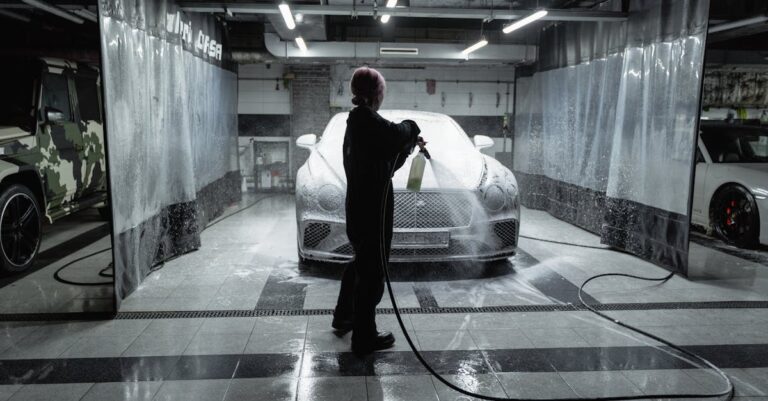Table of Contents
Driving In Rain: Safety Tips Guide
Why Driving in the Rain is Risky Business
Reduced Visibility: Seeing Through the Downpour
Slick Roads and Hydroplaning: Losing Control
Increased Stopping Distances: The Physics of Wet Brakes
Pre-Trip Checks: Setting Yourself Up for Success
Tires: Your Only Connection to the Road
Tread Depth Matters
Proper Inflation is Key
Windshield Wipers: Clear Vision is Non-Negotiable
Lights: See and Be Seen
On the Road: Adjusting Your Driving Style
Slow Down! Speed is Your Enemy
Increase Following Distance: Give Yourself Room
Avoid Cruise Control: Stay Engaged
Gentle Does It: Smooth Steering, Braking, and Acceleration
Dealing with Specific Rain Hazards
Hydroplaning: What It Is and How to Handle It
Deep Water and Flooding: Turn Around, Don’t Drown
Conclusion: Stay Safe When the Skies Open Up
FAQs About Driving in the Rain
Driving In Rain: Safety Tips Guide
Ah, rain. It can be cozy when you’re curled up indoors with a good book, but when you’re behind the wheel? It transforms the familiar act of driving into something potentially treacherous. We’ve all been there – squinting through a blurry windshield, feeling that unnerving lightness in the steering wheel, or suddenly realizing the car ahead is much closer than you thought. Driving in the rain isn’t just inconvenient; it dramatically increases the risk of accidents. But don’t worry, you don’t need to park your car and become a hermit every time the clouds gather. With the right knowledge and precautions, you can navigate wet roads safely and confidently. Ready to become a rain-driving pro? Let’s dive in!
Why Driving in the Rain is Risky Business
So, what exactly makes a bit of water falling from the sky so dangerous for drivers? It’s not just one thing; it’s a combination of factors that gang up on you, reducing your control and awareness. Understanding these risks is the first step towards mitigating them.
Reduced Visibility: Seeing Through the Downpour
This one’s pretty obvious, right? Heavy rain acts like a curtain, drastically cutting down how far you can see ahead. Add spray kicked up by other vehicles, especially big trucks, and it’s like driving through a grey soup. Fogged-up windows, both inside and out, can further obscure your view. It’s simple: if you can’t see hazards – like a stopped car, debris on the road, or a pedestrian – you can’t react to them in time. Think about it: driving requires constant visual input and quick decision making. Rain throws a wrench into that process by limiting the most crucial sense you rely on behind the wheel.
Slick Roads and Hydroplaning: Losing Control
Water doesn’t just make the road wet; it mixes with the oil, grease, and dirt already on the pavement, creating a dangerously slick film, especially during the first few minutes of rainfall (often called “first slick”). This significantly reduces the friction between your tires and the road surface. Less friction means less grip. Less grip means it’s easier to skid or lose control, particularly when braking or turning. Then there’s the dreaded hydroplaning. Ever skipped a stone across a pond? Hydroplaning is similar, but instead of a stone, it’s your car, and instead of a pond, it’s a puddle on the road. When your tires hit water faster than they can channel it away, they can literally lift off the road surface and ride on a thin layer of water. When this happens, you temporarily lose all steering and braking control. Scary stuff, right?
Increased Stopping Distances: The Physics of Wet Brakes
Remember that reduced friction we just talked about? It directly impacts your ability to stop. Your brakes work by creating friction between the brake pads and rotors (or drums). Water on these components, and more importantly, between your tires and the road, reduces the effectiveness of that friction. It takes longer – sometimes significantly longer – to bring your vehicle to a complete stop on wet pavement compared to dry pavement. Slamming on the brakes in the rain is often counterproductive, potentially leading to skids, especially if you don’t have an Anti-lock Braking System (ABS). You need more room, more time, and more gentle inputs.
Pre-Trip Checks: Setting Yourself Up for Success
Okay, we know rain makes driving riskier. So, what can you do before you even turn the key? Plenty! A few simple checks can make a massive difference in how safely you handle wet conditions. Think of it as gearing up for battle – you wouldn’t go out unprepared, would you?
Tires: Your Only Connection to the Road
Your tires are, quite literally, where the rubber meets the road. They are your car’s first line of defense against slippery conditions. Ignoring them is like trying to run a marathon in worn-out flip-flops – you’re just asking for trouble. Healthy tires are crucial for maintaining grip and channeling water away effectively.
Tread Depth Matters
The grooves in your tires aren’t just for looks; they’re designed to funnel water out from underneath the tire, allowing the rubber to stay in contact with the pavement. As tires wear down, these grooves become shallower and less effective at dispersing water. This drastically increases your risk of hydroplaning. So, how do you check? Grab a penny! Insert it into several tread grooves with Lincoln’s head upside down. If you can see all of Abe’s head, your tread depth is below the recommended minimum (typically 2/32 of an inch is the legal minimum, but more is much better for rain), and it’s time for new tires. Seriously, don’t skimp on this – good tires are an investment in your safety.
Proper Inflation is Key
Tire pressure affects how your tires contact the road. Underinflated tires can flex too much, reducing stability and increasing the risk of hydroplaning. Overinflated tires have a smaller contact patch with the road, reducing grip. Check your tire pressure regularly (at least once a month and before long trips) using a reliable pressure gauge. Don’t rely on just looking at them! Find the recommended pressure for your vehicle – it’s usually listed on a sticker in the driver’s side doorjamb or in your owner’s manual – and inflate them to that specification when the tires are cold (meaning the car hasn’t been driven for a few hours).
Windshield Wipers: Clear Vision is Non-Negotiable
If you can’t see, you can’t drive safely. It’s that simple. Your windshield wipers are essential for clearing rain, spray, and debris from your view. But wiper blades don’t last forever. Rubber degrades over time due to sun exposure, temperature changes, and general wear and tear. Worn wipers will streak, smear, or chatter across the glass instead of clearing it effectively, severely impairing your vision, especially in heavy rain or at night. Inspect your blades regularly. Look for cracks, tears, or stiffness in the rubber. Lift the wiper arm away from the windshield and run your finger along the edge (carefully!). If it feels rough or chipped, or if they leave streaks when you use them (even after cleaning the windshield), it’s time for replacements. Replacing wiper blades is inexpensive and usually pretty easy to do yourself. Also, make sure your windshield washer fluid reservoir is topped up – you’ll need it to help clear grime kicked up by other cars.
Lights: See and Be Seen
In rainy, overcast conditions, visibility is already poor. Your vehicle’s lights are crucial not just for helping you see the road, but perhaps even more importantly, for helping other drivers see you. Before heading out, especially if rain is forecast, do a quick walk-around check. Turn on your headlights (low beams are generally best in rain/fog, as high beams can reflect off the water droplets and worsen visibility). Check that both headlights, taillights, brake lights, and turn signals are functioning correctly. Ask a friend to help, or check the reflections in a garage door or shop window. Remember, in many places, it’s legally required to have your headlights on whenever your wipers are in use. It’s a simple rule that significantly boosts your visibility to others.
On the Road: Adjusting Your Driving Style
Alright, your car is prepped, tires are good, wipers are fresh, lights are working. Now it’s time to actually drive. This is where adjusting your habits becomes paramount. Driving in the rain requires a different mindset – calmer, slower, more deliberate.
Slow Down! Speed is Your Enemy
This is the single most important piece of advice for driving in the rain. Speed limits are set for ideal, dry conditions. When the road is wet, you need to reduce your speed accordingly. Why? Firstly, as we discussed, your stopping distance increases dramatically. Going slower gives you more time to react and brake safely. Secondly, the risk of hydroplaning increases exponentially with speed. Even with good tires, driving too fast through standing water is a recipe for losing control. Reduce your speed by at least 5-10 mph from the speed limit in light rain, and even more significantly in heavy downpours or when visibility is very poor. Let impatient drivers pass you; arriving safely is far more important than arriving quickly.
Increase Following Distance: Give Yourself Room
Tailgating is dangerous in any condition, but it’s downright reckless in the rain. Remember those increased stopping distances? You need extra space between your car and the one in front of you to compensate. The standard “three-second rule” for dry conditions should be doubled, at least, in the rain. Aim for a five or six-second following distance. How do you measure this? Pick a fixed object by the road (like a signpost or tree). When the vehicle ahead of you passes it, start counting “one-thousand-one, one-thousand-two…” If you reach the object before you finish counting to five or six, you’re following too closely. This buffer zone gives you precious extra time to react if the car ahead suddenly brakes or swerves.
Avoid Cruise Control: Stay Engaged
Cruise control is a fantastic feature for long, dry highway stretches. But in the rain? Turn it off. Cruise control maintains a constant speed, which might be too fast for changing conditions. More importantly, if you hydroplane while cruise control is engaged, the system will want to maintain speed or even accelerate as the wheels spin freely, potentially worsening the situation and making it harder to regain control. Driving in the rain requires you to be fully engaged, constantly assessing conditions and ready to adjust your speed manually by easing off the accelerator. Keep your foot ready near the pedals and stay alert.
Gentle Does It: Smooth Steering, Braking, and Acceleration
Sudden, jerky movements are your enemy on wet roads. Because traction is reduced, abrupt steering, hard braking, or sudden acceleration can easily cause your tires to lose grip, leading to a skid. Make all your inputs smooth and deliberate. Steer gently into turns. Apply the brakes progressively and softly, well in advance of when you need to stop. Accelerate gradually away from stops or when merging. Imagine there’s an egg under your pedals – you don’t want to break it! Smoothness equals stability when grip is compromised.
Dealing with Specific Rain Hazards
Even with careful preparation and adjusted driving, you might encounter specific, tricky situations. Knowing how to react (or better yet, avoid them) is key.
Hydroplaning: What It Is and How to Handle It
We’ve mentioned hydroplaning, but let’s get specific. It feels like a sudden lightness or looseness in the steering, and your car might momentarily feel like it’s floating or gliding. You might also notice the engine RPMs suddenly jump if the drive wheels lose traction. It happens when your speed and the depth of the water overcome your tires’ ability to channel the water away. If you feel your car start to hydroplane, the absolute worst thing you can do is panic and slam on the brakes or jerk the steering wheel.
Instead:
- Ease your foot off the accelerator smoothly. Do not brake suddenly. Braking can lock the wheels and worsen the skid.
- Keep the steering wheel straight or make only very slight, gentle corrections if needed to keep heading in your intended direction. Don’t make large steering adjustments.
- Wait for the tires to regain traction. As the car slows down, the tires should cut back through the water and reconnect with the road surface. You’ll feel the grip return.
- Once you have control again, you can gently apply the brakes if necessary.
The best way to handle hydroplaning is to avoid it in the first place by slowing down, having good tires, and avoiding puddles or standing water where possible.
Deep Water and Flooding: Turn Around, Don’t Drown
Driving through standing or flowing water is incredibly dangerous and should be avoided whenever possible. It’s often impossible to tell how deep the water actually is, and what hazards might be hidden beneath the surface (like potholes, debris, or even washed-out sections of road). It takes surprisingly little water to stall your engine or even sweep your vehicle away:
- Six inches of water: Can reach the bottom of most passenger cars, potentially causing loss of control or stalling.
- One foot of water: Can float many vehicles.
- Two feet of rushing water: Can carry away most vehicles, including SUVs and pickups.
If you encounter a flooded roadway, intersection, or underpass, don’t risk it. Follow the crucial advice: Turn Around, Don’t Drown. Find an alternative route. It might take longer, but it could save your car, and more importantly, your life. Never assume the water is shallow enough or that your vehicle can make it through.
Conclusion: Stay Safe When the Skies Open Up
Driving in the rain doesn’t have to be a white-knuckle experience. By understanding the risks involved – reduced visibility, slippery roads, longer stopping distances – and taking proactive steps, you can navigate wet weather with much greater safety and confidence. Remember the keys: prepare your vehicle beforehand (especially tires, wipers, and lights), significantly slow your speed, increase your following distance, avoid cruise control, make smooth inputs, and never, ever attempt to drive through flooded areas. It’s about respecting the conditions, staying alert, and adjusting your driving accordingly. So next time the raindrops start falling, take a deep breath, recall these tips, and prioritize safety above all else. Drive smart, stay safe!
FAQs About Driving in the Rain
1. Is it safer to drive in the tracks of the car ahead of me in the rain?
Generally, yes. The car ahead can displace some of the standing water, potentially providing a slightly drier path with better traction for your tires. However, don’t follow too closely – maintaining that increased following distance is still paramount for safety.
2. What should I do if my car starts to skid on a wet road (not hydroplaning)?
Similar to hydroplaning, avoid slamming the brakes. Smoothly ease off the accelerator. Look and gently steer in the direction you want the car to go (often called “steering into the skid”). For example, if the rear of your car is sliding to the right, gently steer to the right. As the car straightens out, gently straighten the wheel. Keep your inputs smooth.
3. Are fog lights helpful in the rain?
Fog lights cast a low, wide beam designed to illuminate the road surface directly ahead without reflecting off fog droplets. They can sometimes be helpful in very heavy rain or road spray by improving short-range visibility near the front of the car. However, use them judiciously; ensure your regular low-beam headlights are also on, and turn fog lights off when conditions improve, as they can be distracting or glaring to other drivers in lighter rain or clear weather. Never use rear fog lights unless visibility is severely reduced (less than 50 meters/165 feet), as they are very bright and can be mistaken for brake lights.
4. Why does my car sometimes feel like it’s pulling to one side when braking in the rain?
This could indicate a few issues. It might be uneven brake wear or a problem with the braking system itself, which becomes more apparent when traction is low. It could also be caused by uneven tire pressure or wear, or hitting a patch of water more heavily on one side than the other. If your car consistently pulls to one side when braking, especially in the wet, get your brakes and alignment checked by a mechanic.
5. How soon after it starts raining is the road most slippery?
Roads are often most slippery during the first 10-15 minutes after rain begins. This is because the rainwater mixes with accumulated oil, grease, and dirt on the road surface, creating a particularly slick film. After it rains for a while, some of this grime gets washed away, though the road remains hazardous due to the water itself.









